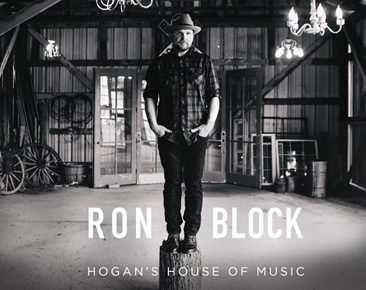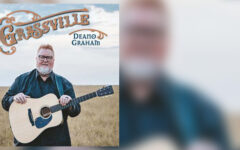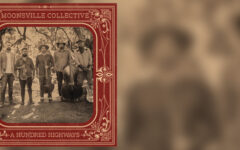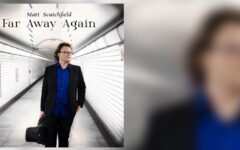
 Growing up, Hogan’s House Of Music was where a young Ron Block learned the beauty and variety of popular music. The retail music emporium was owned and operated by his father in Lawndale, CA and the future guitar and banjo virtuoso spent a lot of time there in his youth.
Growing up, Hogan’s House Of Music was where a young Ron Block learned the beauty and variety of popular music. The retail music emporium was owned and operated by his father in Lawndale, CA and the future guitar and banjo virtuoso spent a lot of time there in his youth.
Long before Alison Krauss brought the talented musician, vocalist, and songwriter into her band, Ron was a regular at Hogans, and it left quite a mark on the teen-aged striver. So much so that he has titled his new, and first fully-instrumental album of his career in honor of the store where it all began for him.
“Dad had worked for Frank Hogan a long time, and when Mr. Hogan died in the late 1960s he left half the store to Dad. Dad bought the other half from Mr. Hogan’s daughter. Some of my earliest memories were the smell of old guitars, cases, and amps, a pot of coffee, and guys sitting around playing. At around ten or eleven I’d sometimes go there with Dad and my stepbrother to pull weeds in the back, clean cymbals, and do other odd jobs. I started work there at sixteen, first as cleaning boy, then salesman, and later as the warehouse man. Dad would constantly get used instruments in, and in those days a ’64 Strat was ‘a really sweet guitar,’ not a vintage classic worth as much as a house. I polished many ’50s and ’60s Les Pauls, Strats, Teles, 335s – you name it, I polished it.
The guys there were always playing music, either on the stereo or on a guitar, drums, or keyboards. I heard a lot of great music, that kind of passionate rock-and-roll, blues, and jazz that hits you below the neck. At the same time in my room at home I was completely immersed in traditional bluegrass – Flatt & Scruggs, Bill Monroe, the Stanley Brothers, Larry Sparks, Jimmy Martin, J.D. Crowe, and other seminal bands and players. Those two streams would seem to clash, but they really didn’t in me. At first I thought bluegrass was the only good kind of music, because I was going through those early years of immersion, but by about 18 I bought a Les Paul, and later a Strat. So I’ve had these three streams running through my music, all mixing together for years: acoustic guitar, electric guitar, and banjo, and the techniques translate somewhat from one to another. It made me into a banjoist and acoustic guitarist with a traditional bluegrass right hand, yet with sometimes a very string-bending approach.”
Hogan’s House of Music is a self-produced project, containing 16 banjo instrumentals split roughly in half between classic tunes and Ron’s new contributions. While banjo is the focus, taking lead on most of the tracks, Ron’s superb flatpicked guitar is prominent as well taking solos on almost every tune with Dan Tyminski providing solid rhythm guitar on most of the record, with Clay Hess handling the rest.
Just as Ron described his passion for a variety of musical styles above, the embrace of various approaches is in evidence on this new CD. The more traditional bluegrass banjo of his youth is ably represented by solid renditions of Ralph Stanley’s Clinch Mountain Backstep and a pair of Earl Scruggs classics, Lonesome Road Blues and Home Sweet Home. On these numbers, Block largely eschews the more modern banjo approach he has long been known for and instead honors the contributions of Scruggs and Stanley, other than an up-the-break on Clinch Mountain with lots of fun bendy licks.
The same is true on You Are My Sunshine, played in D-tuning a la Don Reno’s version of Home Sweet Home, replete with Scruggs tuners. But on this one, Ron reverts to form and includes a mega-funky blues break in the middle which is picked up by Stuart Duncan on fiddle.
Several traditional folk tunes are presented, none more brilliant than the duet between Ron’s banjo and Sierra Hull’s mandolin on Seneca Square Dance. The precision of their timing and their unison/harmony treatment at the end is a real treat. Brushy Fork of John’s Creek and The Spotted Pony are fine too, with Sierra adding octave mandolin to Adam Steffey’s mando, and Alison Krauss playing a second fiddle to Stuart Duncan on the latter.
There is also a fast-charging take on Wolves A-Howling, with a bit of a Cotton Eyed Joe feel. Block’s banjo is out front, and on point, with stellar contributions from Steffey and Duncan.
But the most impressive performances are on Ron’s original tunes, from the quirky, modern grass vibe of the album opener, Smartville, to the rocking’ drive of ’65 Mustang Blues, with guests Sam Bush and Jerry Douglas joining Block for a mid-tempo blues romp. Calico offers a more melancholy mood, led by the banjo but with multiple string parts from Tim Crouch, and mando parts galore from Hull.
Carter’s Creek Pike is perhaps his most traditional sounding composition, again played with Scruggs tuners, and assistance from Bush and Douglas. The modal fiddle tune gets a nod in Ron’s Mollie Catherine Carter, with a bit of a crooked twist. Perhaps the magnum opus is Mooney Flat Road, a Celtic-flavored tune, with Krauss and Duncan twinning again on fiddle, and Steffey and Hull on mando and octave mando.
It’s on this point that Ron said his decision to make an instrumental album was based – the question of original material. That, and the freedom of some time in his schedule.
“I realized it was long past time to do it, and I had the time to do it. For years AKUS was so busy I didn’t need to think about doing solo records very often. As the years go by and AKUS touring is scheduled more in the summer and the rest of my time is more open, I find myself still wanting to create and play music. That’s one factor.
Another is this: For a long time I considered myself a songwriter, not a banjo tune composer, and also in AKUS we are very vocal-driven. I’ve been mostly a banjoist who plays on vocal tunes; I love backing up vocals and other instruments in a band context. So I haven’t considered myself a composer of instrumentals. But in all these things I’ve changed my view. If we say, ‘I can’t do it,’ then it is certainly true. Sometimes we have to jump into things not knowing what will happen.
I remember years ago my wife and I used to watch a show called Inside the Actor’s Studio. The host would always ask high-level actors like Sally Field or Richard Dreyfuss, ‘What made you choose that script? How did you decide that part was something you wanted?’ And they would always answer something along the lines of what Dreyfuss said, ‘Because it scared me to death.’ Growth happens when we get out of our comfort zone. Sometimes we have to see ourselves differently before we will move off of our established ground.
I have long been a fan of instrumental music. I’ve worn out copies of Foggy Mountain Banjo, Jimmy Martin’s Big and Country Instrumentals, Bela Fleck’s Drive record, Pat Metheny records, Larry Carlton, and many others. For the past ten years Jens Kruger and the Kruger Brothers have been a big inspiration. So in reality it’s not a big shift to doing it myself.
I modeled Hogan’s House of Music mostly after Foggy Mountain Banjo and Big and Country Instrumentals. A lot of Foggy Mountain Banjo is primarily banjo-driven. But Big and Country Instrumentals has more space for the other instruments, especially fiddle, and I wanted to play guitar on it, too, so I left room for that.”
Hogan’s House Of Music satisfies on every level. Fans of great picking will revel in the crisp playing and the lovely tones, whiles more general music fans will appreciate the beauty of the original tunes and the classic melodies.
Look for the album wherever bluegrass music is sold.







